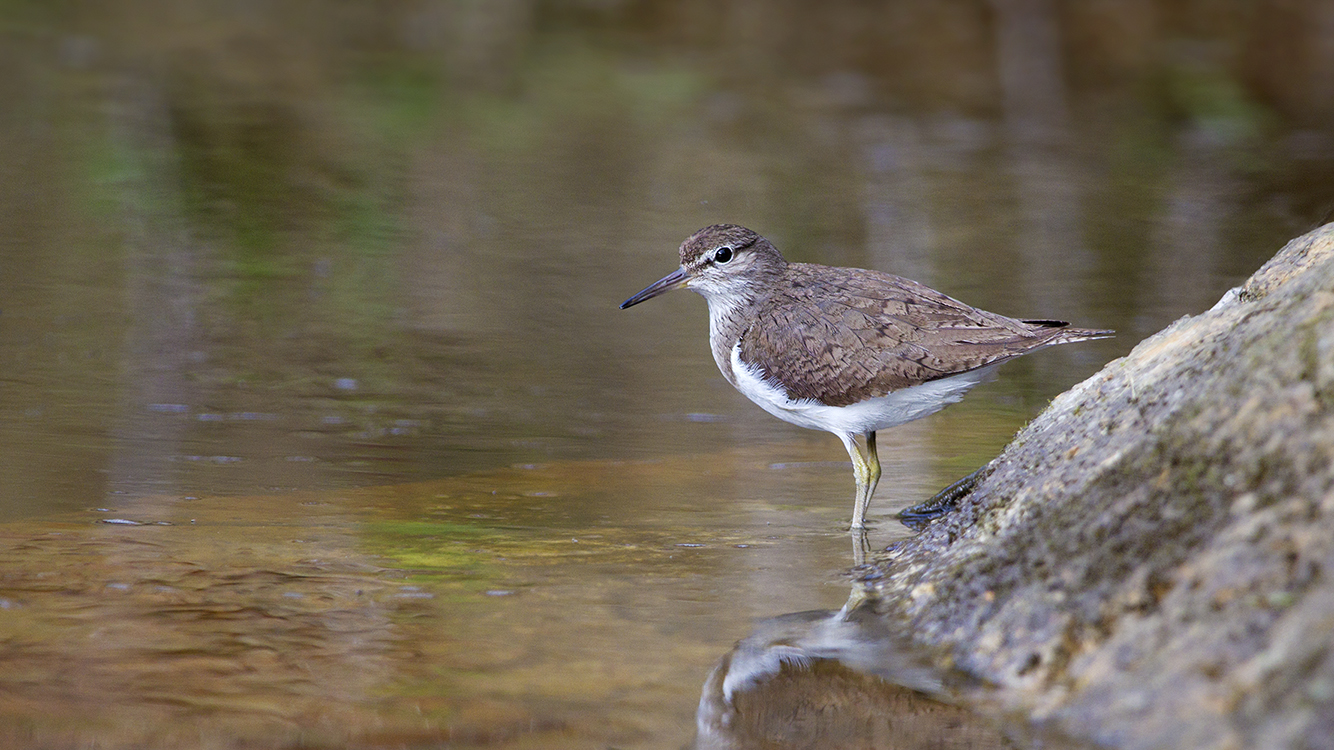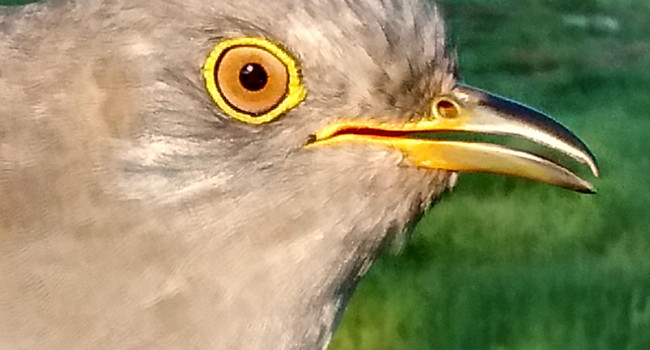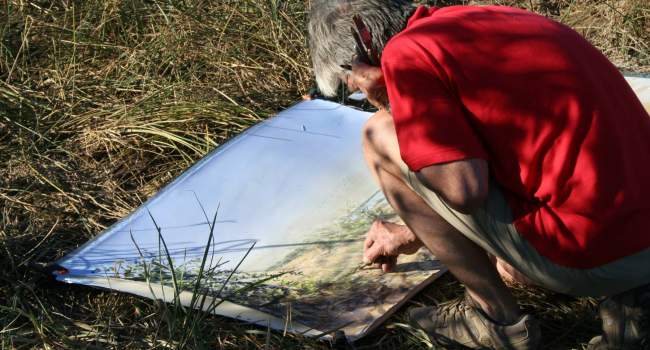
Migration blog (mid July - early August)
June is typically one of the quietest months for migration with birds generally settled with a mix of adult birds breeding and, for some species, imature birds that are too young to breed and are just going through the motions. Some species, such as immature terns, remain further south during the summer. The past month has seen some wader species such as Green Sandpiper, Curlew Sandpiper, and Common Sandpiper turning up at various locations. At this time of year it can be difficult to know if they are late birds heading north to breed, or more likely failed breeders heading south. One wader species that does typically start to arrive from late June as part of an ‘autumn’ migration is Spotted Redshank and this year has been no different, as shown by the BirdTrack reporting rate graph that shows an increase in records in late June. Most of these will be females that have successfully mated and left the incubation and rearing of the young to the males. Other wader species also returning in the last couple of weeks include Ruff, Common, Wood, and Green Sandpiper – again these will be adult birds and numbers will continue to build over the coming weeks before the first of this year's young join them later in the summer.
Common Scoter reports also increased during June, and numbers start to build from late June all the way through to the winter. Many of these reports came from inland waters and with Common Scoter recorded more frequently by nocturnal migration sound recorders, we are starting to realise how frequently this maritime duck passes over land and the routes they take.
Late June has always had the reputation of producing some very rare birds and this June was no exception with top spot going to two new species for Britain, a Sulphur-bellied Warbler in Lundy, Devon and a Soft-plumaged Petrel that was tracked up the east coast from North Yorkshire to Northumberland. An Egyptian Vulture spent a couple of days on the Isles of Scilly and would have proved very popular had it hung around as it represented the first record in over 150 years. Other rarities recorded included Least Tern (Dublin), Red-winged Blackbird (Sligo and Mayo), Elegant Tern (Anglesey), White-tailed Lapwing (Kent), Black-browed Albatross and Oriental Turtle Dove (East Yorkshire), Red-necked Stint (Northumberland), Calandra Lark and Green Warbler (Fair Isle), Baillon’s Crake (Lincolnshire and Wicklow), Pacific Swift (Glamorgan and Northumberland), River Warbler (Somerset and Bristol), Caspian Stonechat (Shetland), Short-billed Dowitcher and Semipalmated Plover (Cork), and Little Swift (Isles of Scilly and Cornwall).

Species Focus - Balearic Shearwater
Balearic Shearwater was once thought to be a type of Manx Shearwater but was split from Manx Shearwater to become Mediterranean Shearwater and a few years later Mediterranean Shearwater was split again into Balearic Shearwater and Yelkouan Shearwater. Balearic Shearwater is a summer and autumn visitor to our waters and is the only bird to occur in Britain and Ireland that is listed as critically endangered on the IUCN Red List. As its name suggests, it has a very restricted breeding area in the Balearic Islands and the population is small too, estimated to be around 20,000-30,000 individuals, hence its critically endangered status. Fossil records indicate that Balearic Shearwater was a common species across the Balearic Islands but after human colonisation some 4,200 years ago the population declined. This decline is attributed to being harvested for food and to the introduction of predators, the latter still being a threat to their population today, combined with fishery by catch, pollution and overfishing.
The first birds begin to arrive in British and Irish waters around mid-May, undertaking a post-breeding dispersal out of the Mediterranean and into the North Atlantic, with numbers peaking in July, August and September. During the early part of the season most birds are seen in our southern waters but as the summer progresses they can be found further north and in the North Sea. A small number winter here, mostly in the south but the majority begin to leave in September, heading back to their Mediterranean breeding grounds.
Terns will also be on the move with late July the peak time for Common, Arctic, and Little Tern often found in mixed flocks that could include the occasional Black Tern or Roseate Tern.
Looking ahead
A high pressure system looks to be taking hold over most of Britain and Ireland as we approach the weekend, bringing with it more settled warmer conditions with many places seeing temperatures in the mid to late 20s. Given these settled conditions, which look to last several days, and the time of year it is unlikely that there will be any significant migration taking place as we head towards August. That said, there will be some species on the move. Waders in particular will continue to arrive as adults head southwards over the coming weeks. Spotted Redshank, Green, Wood and Common Sandpipers, Ruff, Curlew, Black-tailed Godwit and Curlew Sandpiper numbers will arrive in increasing numbers and are typically the first of the waders to head south.
Terns will also be on the move with late July the peak time for Common, Arctic, and Little Tern often forming mixed flocks that could include the occasional Black Tern or Roseate Tern. These mixed flocks can turn up anywhere there is water and can pass some coastal locations in huge numbers. Little Gulls will also join these flocks and their dark underwing is a great way of picking them out from similar sized terns when in flight. Little Gulls can also gather in large numbers and contain a mix of adult birds, first summers and the first of this year's young, allowing comparisons between all the different age groups.

Swift is a typical late summer migrant with gatherings of birds hawking for insects as they move south. Spurn Point, East Yorkshire, is probably the prime location in Britain and Ireland with triple figure counts are not uncommon at this time of year and occasional rare swifts with them, such as Pacific or Little. You don’t need to head to Spurn to see gatherings of Swifts – they form screaming parties over towns and cities in the evening at this time of year, and during wet or windy weather they can gather over lakes and reservoirs, or on the leeward side of trees as they search for food.
Seabird numbers start to build in early August with the reporting rates for Manx, Cory’s, and Great Shearwater all increasing as birds pass the coast of Britain and Ireland. Manx Shearwater undertake a post-breeding migration and migrate to the South Atlantic, with the fledged young leaving in mid-August to mid-September. Cory’s Shearwater spends July to October in the North Atlantic before heading south along the coast of northern Africa and can be seen often be seen from south western headlands during onshore winds. Great Shearwaters breed in the South Atlantic, but as part of their circular migration, occur in the North Atlantic between July and November and like Cory’s Shearwater can be seen from our shores given the right conditions, often onshore stormy weather.
Possible scarcer species to look out for in the coming weeks include Broad-billed Sandpiper, Caspian and Whiskered Tern, Wilson’s Petrel and Black-winged Pratincole.
The dates have been announced for the Spurn Migration Festival. Between the 10-12 September 2021 the magic of migration will be live from North Field in Kilnsea, with the now familiar format of walks, talks, workshops, and of course, autumn bird migration. The festival is a weekend-long celebration of the migration of birds, delivered by the Migration Festival Team all keen to share the wonders of birds, migration and other wildlife with you. The festival starts on Friday evening 10 September and closes at Sunday teatime 12 September and the event takes place across Spurn, Kilnsea and Easington. A warm and friendly welcome awaits, with an extensive programme of walks, talks, demonstrations, exhibitions and food. Tickets can be purchased here.







Share this page